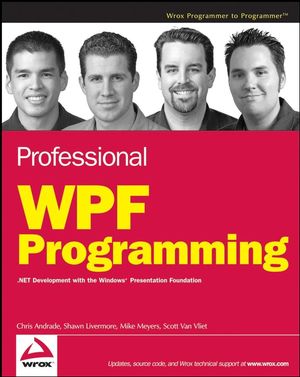Professional WPF Programming: .NET Development with the Windows Presentation FoundationISBN: 978-0-470-04180-2
Paperback
480 pages
May 2007
 This title is out-of-print and not currently available for purchase from this site.
|
Acknowledgments ix
Introduction xix
Chapter 1: Overview of Windows Presentation Foundation 1
A Brief History of the Windows API 2
Platform Evolution 2
Introducing .NET Framework 3.0 3
Meet Windows Presentation Foundation 3
Guiding Design Principles 3
Architecture 5
XAML 15
Declarative vs. Imperative 15
Visual Design Tools 18
XamlPad 18
Microsoft Expression Blend 19
Visual Designer for Windows Presentation Foundation 20
Electric Rain ZAM 3D 21
Mobiform Aurora 22
Summary 23
Chapter 2: WPF and .NET Programming 25
Getting Started 26
Required Installations 26
Types of WPF Applications 26
My First WPF Application 27
WPF Development Concepts 29
XAML 29
The Application Object 30
Creating the User Interface 32
Handling Events 35
Working with Controls 41
Triggers 51
Language Support 58
Deployment 61
Summary 61
Chapter 3: Anatomy of a WPF-Enabled Application 63
Project Composition 63
App.Manifest 66
AssemblyInfo.cs 66
Resources.resx 68
Settings.settings 68
MyApp.xaml 70
.NET Framework 3.0 Windows Application 71
Window1.xaml 72
XAML Browser Application 73
Page1.xaml 73
WCF Service Library 75
Class1.cs 75
WPF Custom Control Library 78
UserControl1.xaml 79
Summary 82
Chapter 4: Building a Rich UI with Microsoft Expression Blend — Part I 83
Overview 84
The Design Environment 85
Workspace Panels 86
The Artboard 87
Configuring the Environment 88
Project Structure 90
Adding a New Project File 90
Building and Deploying a Project 91
Creating Vector Objects 91
Shapes 92
Paths 93
Manipulating Objects with the Properties Panel 94
The Transform Panel 94
The Brushes Panel 95
Opacity, Transparency, and Visibility 97
Manipulating Text 98
Managing Layouts 99
UI Layout Panels 100
Other Layout Controls 103
Nesting Layout Panels 103
Animation 104
Timeline Sub-Panel 104
Keyframes 105
Animate an Object’s Property 106
Motion Paths 106
Triggers 107
Creating Controls 108
Templates 110
Styles 111
States 112
Importing Audio/Video Media 113
Summary 113
Chapter 5: Building a Rich UI with Microsoft Expression Blend — Part II 115
Expression Blend Workflow 116
Code Editing with Visual Studio 2005 117
Handling User Input 118
Keyboard and Mouse Classes 118
Events and Event Handling 118
Positioning 120
Hit Testing 124
The WPF Animation API 135
Animation Classes 135
Creating a Dynamic Animation Procedurally with Code 135
Programmatic Animation 139
Interacting with Storyboards 143
WPF Drawing API 145
Geometry 145
Shapes 146
Brushes 149
Summary 153
Chapter 6: Special Effects 155
Brushes 156
SolidColorBrush 156
GradientBrush 162
ImageBrush 165
DrawingBrush 167
VisualBrush 169
Bitmap Effects 171
Transformations 175
TranslateTransform 178
ScaleTransform 180
SkewTransform 183
RotateTransform 186
Opacity Masks 188
Putting It All Together — Combining Effects 191
Bouncing Ball with Reflection Example 191
Animated Image Viewer Example 197
Summary 203
Chapter 7: Custom Controls 205
Overview 206
Control Base Classes 207
The UserControl Class 207
Creating a User Control 207
Data Binding in WPF 217
Binding Markup Extensions 217
Binding Modes 217
Data Templates 219
Data Conversions 221
Creating and Editing Styles 222
Specifying a Style’s Target Type 223
Inheriting and Overriding Styles 224
Style Triggers 226
Customizing Existing Controls with Templates 228
Summary 231
Chapter 8: Using WPF in the Enterprise 233
WPF Application Models 234
Standalone Applications 235
Browser-Based Applications 238
Security Considerations 247
State Management 248
Application Object 248
Isolated Storage 250
State Management Example 252
Navigation 258
Elements of Navigation 258
Structured Navigation 259
Navigation Topologies 269
Application Localization 286
Automatic Layout Guidelines 287
Using Grids for Flexibility 289
Localization Attributes and Comments 290
WPF Deployment Models 291
Building Applications 292
Deploying Standalone Windows Applications 294
Deploying XAML Browser Applications 295
Deploying the .NET Framework 3.0 Runtime 296
Summary 298
Chapter 9: Security 299
WPF Security Model 299
Trusted Versus Express Applications 300
Core OS Security 300
LUA 301
Virtualization 301
Sandboxing 301
Cryptography Next Generation 302
CLR Security 302
Code Access Security 303
The Critical Code Methodology 311
Verification 313
Microsoft Internet Explorer Security 313
Zone Restrictions 313
XBAP Sandbox Workarounds 314
XAML Browser Application Security 315
ClickOnce Security 323
Trusted Publishers 323
Personal Certificate File 324
.NET 3.0 Security Utilities 327
Summary 328
Chapter 10: WPF and Win32 Interop 329
Win32 User Interface Overview 330
How WPF and HWNDs Interoperate 330
Using Win32 HWNDs Inside of WPF 331
Hosting a Win32 Button in WPF 332
Using WPF in Win32 Applications 335
Adding Windows Forms Controls to WPF 337
Adding Your WindowsFormsHost in Code 337
Adding Your HwndHost in XAML 339
Adding ActiveX Controls to WPF 339
Adding the ActiveX Control in XAML 344
Adding WPF Controls to Windows Forms 345
Affecting Control Properties 349
Summary 351
Chapter 11: Advanced Development Concepts 353
WPF Architecture 354
Core Subsystems 356
WPF Threading Model 359
Desktop Window Manager 360
The WPF Framework 361
Dispatcher Object 362
DependencyObject/DependencyProperty 362
Application 363
Freezable 364
Visual 364
UIElement 370
FrameworkElement 371
Control 371
A Deeper Look at XAML 373
XAML Under the Hood 373
Manipulating XAML On-the-Fly 378
Deconstructing Window1.xaml 382
x:Class 383
XAML Markup Extensions 385
XAML and Custom Types 386
WPF Multithreading 388
Single-Threaded Application Model 388
Thread Affinity and DispatcherObject 389
WPF Dispatcher 390
Working with Single-Threaded Applications 391
Asynchronous Threading 393
Windows Communication Foundation 397
Service Orientation 397
WCF Architecture 398
WCF Fundamentals 399
Building a WCF Service 402
Windows Workflow Foundation 409
Workflow Defined 410
WF Architecture 411
WF Fundamentals 411
Summary 427
Index 429



